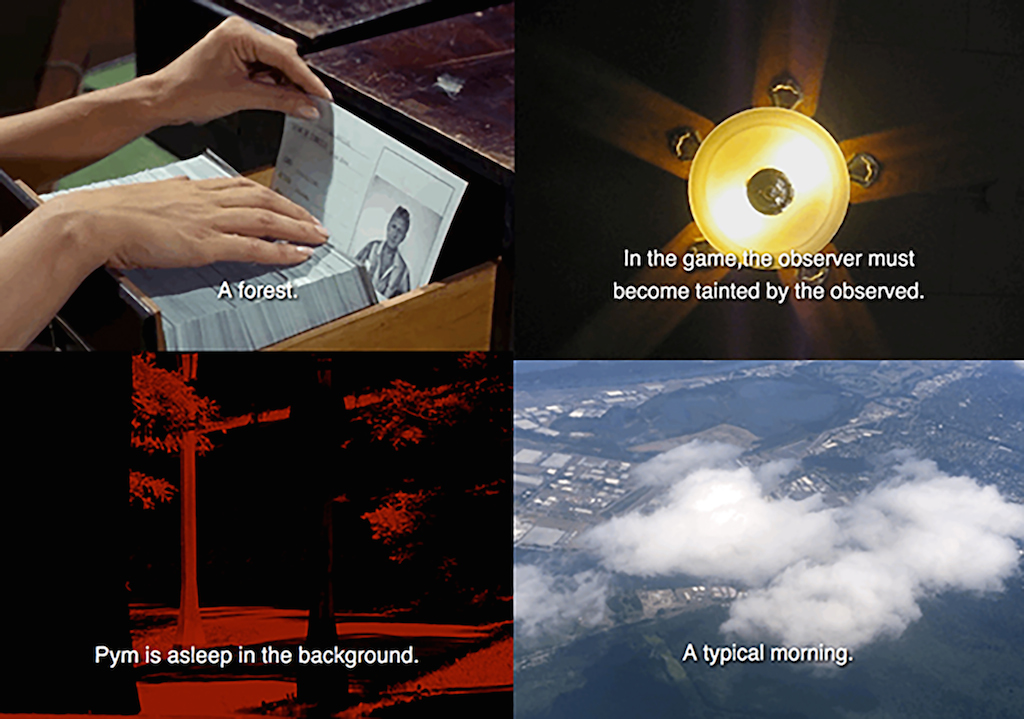Hyperrhiz 14
Phantom Agents: Variability in Narrative Fiction
Will Luers
Washington State University Vancouver
Citation: Luers, Will. “Phantom Agents: Variability in Narrative Fiction.” Hyperrhiz: New Media Cultures, no. 14, 2016. doi:10.20415/hyp/014.f08
Abstract: The story of Phantom Agents depicts the adventures of two characters inside a broken augmented reality game. The remix of spy films and secret agent tv shows is intended as hauntings from another century.
Artist Statement
In Phantom Agents, my aim was to create narrative sequence (or at least the semblance of temporal progression) within an interface that was indeterminately arranged with image selections, text fragments and design elements. I wanted an episodic narrative that included its own variability as spatial structure, as plot and as theme. Why? Recombinant works of art use deterministic and variable processes to produce "fields of meaning" where "a finite set of media-elements is entertained through a vast set of potential combinatorial abstractions (Rieser, 242)." This "recombinant" state of things is very familiar to me at the beginning of the internet age. We think of ourselves as agents in a system that is constantly changing the rules and purpose of play. It is exhilarating and exhausting. We wake up, login and negotiate the day's novel data into our bodies. The story of Phantom Agents depicts the adventures of two characters inside a broken augmented reality game. The game, its purpose and backstory is never explained, if only to introduce a familiar disorientation. The remix of spy films and secret agent tv shows is intended as hauntings from another century, but their stochastic juxtapositions (sometimes meaningful, sometimes not) presents a disembodied, networked and gamified world in which identity and agency are lost to endless novelty. Phantom Agents is metamorphic text, a subset of ergodic cybertext that transforms "endlessly with no final (and repeatable) state to be reached" (Aarseth, 181).

The work's narrative and generative system emerged symbiotically. It is not only that there are narrative rationales for stochastic systems, but that these systems produce affect that complicate, disrupt and infect the narration. Built with HTML5 and JavaScript, I used a few simple programming principles to compose, simultaneously and iteratively, the narrative structure and the recombinant system. Random text fragments, images and design elements are held in arrays, as are the sequenced fragments. With each swipe or click forward in the work, the interface draws from the sequenced arrays in increments (i++) and from the random arrays using a javaScript random number (Math.random()). Once that basic system was built, my role as a narrative artist took over and I filled the arrays with the media fragments that play with each other, that resonate and mirror what the system is doing, as well as impart the bare necessities of plot, character and setting. Interface design was yet another layer of refining edges between the stochastic process and the narrative structure. As a recombinant fiction, the work is playfully about itself, simulating the murky and liminal realms of networked experience rather than a believable inner or outer reality.
Works Cited
Aarseth, Espen J. Cybertext: Perspectives on Ergodic Literature. Baltimore, Md: Johns Hopkins University Press, 1997. Print.
Rieser, Martin, and Andrea Zapp, eds. The New Screen Media: Cinema/art/narrative. Pap/DVD edition. London: British Film Institute, 2002. Print.